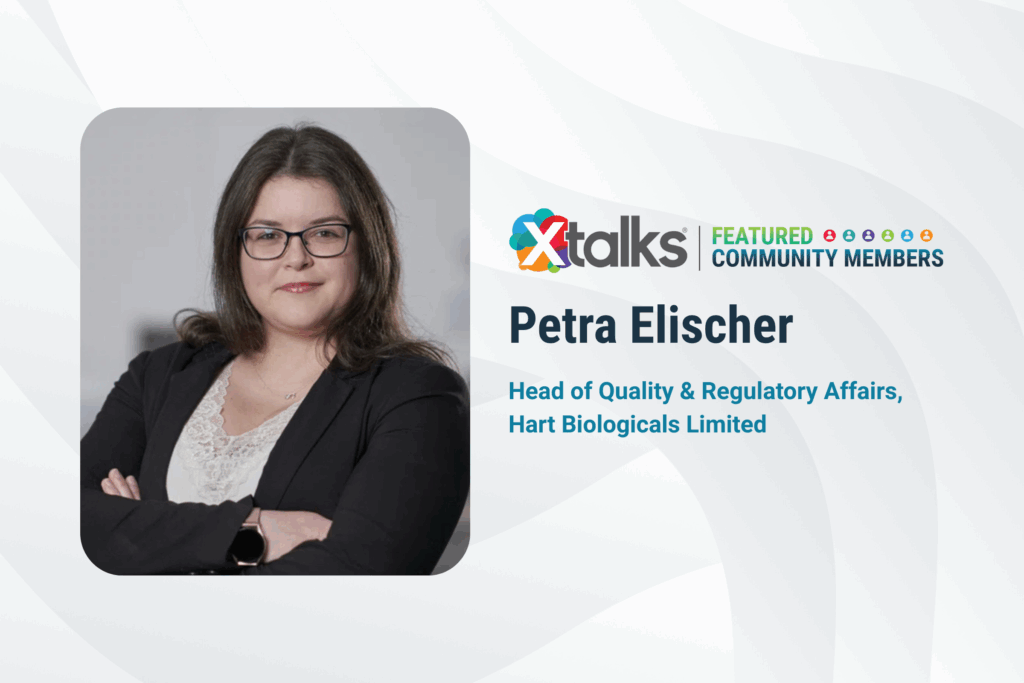Meet Xtalks Featured Community Member Petra Elischer, Head of Quality and Regulatory Affairs at Hart Biologicals Limited, whose leadership has fostered a culture of excellence and collaboration across teams and supplier partnerships. Her dedication to advancing quality standards and empowering team members has created a foundation for continuous improvement and long-term organizational success. Read her perspective on fostering a culture of quality and continuous improvement.
What Are Your Proudest Life Science Achievements?
One of my proudest accomplishments has been establishing and nurturing strong relationships with our suppliers. By fostering open communication, trust and mutual respect, I have created a collaborative environment that encourages transparency and continuous improvement. This has not only ensured the consistent delivery of high-quality materials and services but also built a foundation for strategic partnerships that benefit both parties.
Simultaneously, I have been dedicated to promoting a culture of quality within the organization. By emphasizing the importance of quality standards and encouraging a mindset of excellence, I have helped embed quality as a core value across teams. This focus on quality has led to improved processes, reduced defects and increased customer satisfaction.
Furthermore, I am passionate about developing team members and empowering them to reach their full potential. I have mentored and coached individuals, providing them with the skills, knowledge and confidence needed to excel in their roles. I prioritize creating opportunities for growth and learning, which has enabled many team members to achieve promotions, secure their dream jobs and realize their career aspirations.
Overall, these efforts have contributed to a more cohesive, motivated and high-performing team while also strengthening our supply chain and elevating the organization’s reputation for quality.
What Are Your Day-to-Day Job Highlights?
A key highlight of my daily responsibilities is cultivating a workplace environment where people genuinely care about quality. I actively engage with team members, encouraging them to take ownership of their work and to adopt a mindset of continuous improvement. By fostering open communication and emphasizing the importance of quality in every task, I help embed these values into our day-to-day operations.
An especially rewarding aspect is witnessing team members become confident in their ability to speak up. I create a safe space where everyone feels comfortable voicing their concerns, questions or suggestions without fear of retribution. This open dialogue not only helps identify potential issues early but also empowers individuals to contribute actively to maintaining high standards.
In practice, this means I regularly facilitate team discussions, perform quality walkthroughs and provide coaching to reinforce the importance of attention to detail. Seeing team members develop the confidence to speak up and prioritize quality over shortcuts is fulfilling, as it directly contributes to a culture of integrity, accountability and shared responsibility for collective success.
What Are Your Favorite Life Science Innovations?
From a personal perspective, one of my favorite areas of innovation in life sciences is the advancement in cell-based therapies for skin disorders and specifically for burn care. Over the last decade, we’ve seen remarkable progress in the development of treatments that fundamentally transform how we approach wound care and skin regeneration. This includes a diverse array of technologies, starting from advanced wound covers designed to promote healing and prevent infection, to the innovative use of nanoparticles that deliver targeted therapeutic agents directly to affected areas.
More recently, there has been a breakthrough with spray-on skin technologies, which allow for rapid and less invasive skin regeneration, particularly critical in burn care. These spray-on solutions involve the application of bioengineered skin cells and scaffolds that can seamlessly cover large or difficult-to-access areas, significantly reduce recovery time and improve outcomes for burn victims.
This evolution, from traditional wound dressings to sophisticated nanotechnology and regenerative sprays, has revolutionized burn care and skin disorder treatments. It exemplifies how combining biology, engineering and cutting-edge materials science can lead to life-changing therapies, restoring not just the skin but also the confidence and quality of life for patients.
From a professional perspective, there are two innovations I particularly favor. The first one is advancements in platelet testing, which are revolutionizing the way we diagnose, manage and treat blood clotting and bleeding disorders. These developments include more rapid and comprehensive functional assessments, personalized antiplatelet therapy management and enhanced diagnostic accuracy for bleeding or thrombotic conditions. The creation of faster and more detailed platelet function tests allows clinicians to assess platelet activity more accurately in real-time. Techniques like point-of-care testing enable rapid evaluation of platelet aggregation, adhesion and secretion processes, facilitating timely decision-making during surgeries or in critical care settings.
Personalized antiplatelet drug management is made possible through these advanced testing methods. By precisely measuring an individual’s platelet response to antiplatelet agents such as aspirin or clopidogrel, healthcare providers can tailor treatment regimens to optimize efficacy and minimize adverse effects like bleeding complications. This individualized approach enhances patient safety and treatment outcomes.
Overall, improved diagnostic tools allow for better identification of bleeding or thrombotic disorders. Enhanced sensitivity and specificity help detect subtle abnormalities in platelet function, leading to more accurate diagnoses and targeted therapy. This not only benefits patients with inherited platelet dysfunctions but also those with acquired conditions such as dual antiplatelet therapy resistance or platelet dysfunction secondary to other diseases.
These advancements in platelet testing are paving the way for more precise, efficient and personalized management of clotting disorders, ultimately improving patient care and outcomes in hematology and cardiovascular medicine.
The second innovation is the movement away from traditional ethylene oxide (EO) sterilization toward more advanced, environmentally friendly and safer technologies, which reflects ongoing innovations in sterilization science aimed at better efficacy, reduced health risks and greater compatibility with sensitive medical devices. These emerging sterilization methods include vaporized hydrogen peroxide (VHP), nitrogen dioxide (NO₂), supercritical carbon dioxide (ScCO₂), ozone (O₃) and low-temperature plasma (LTP) sterilization. Each of these technologies offers unique advantages and has been increasingly adopted in healthcare settings.
What Is Your Vision for the Future of the Industry?
The future vision for the industry evolves around creating a compassionate, collaborative and inclusive environment where people truly share and care for one another. This vision emphasizes building a strong community in which everyone’s voice matters, whether patients, healthcare professionals, researchers or industry stakeholders, fostering a culture of openness, respect and mutual support.
In this envisioned future, innovations and advancements are driven not only by technological progress but also by a collective commitment to ensuring that every individual’s needs and perspectives are heard. This means actively encouraging dialogue and listening to feedback to develop solutions that are truly responsive and beneficial for all.
A key aspect of this vision is fostering a sense of partnership, where companies, healthcare providers, patients and policymakers work together as a unified community. By sharing knowledge, resources and best practices openly, we can accelerate innovation, improve safety standards and reduce costs, making high-quality devices and treatments more accessible and affordable for everyone.
Moreover, this industry’s future involves a strong focus on sustainability and ethical responsibility, ensuring that products optimize patient safety while minimizing environmental impact. It’s about creating a supportive ecosystem where everyone feels empowered to contribute, learn and grow, knowing that their efforts can lead to meaningful improvements in healthcare.
Ultimately, the vision is to build an industry where kindness, trust and collaboration are as integral as cutting-edge science and technology. In this environment, we can collectively help each other succeed, ensuring that safe, effective and affordable devices reach those who need them most, improving outcomes, fostering hope and creating a healthier, more compassionate world.
Apply Yourself or Nominate a Peer
Do you know someone doing incredible work in the life sciences? Or perhaps you’re proud of your own journey and want to inspire others? We’d love to hear from you.
You can apply to be an Xtalks Featured Community Member or nominate a colleague through our simple online form. It takes just a few minutes, and it could open doors to new conversations, partnerships and recognition across the industry.
Let’s celebrate the people driving life sciences forward, one story at a time.








Join or login to leave a comment
JOIN LOGIN